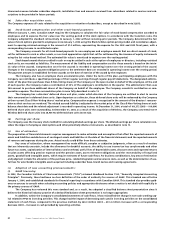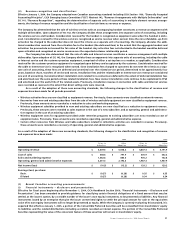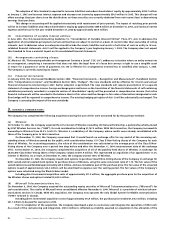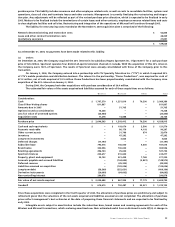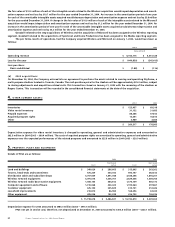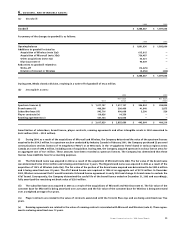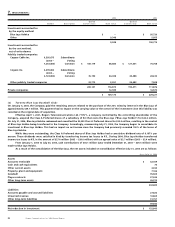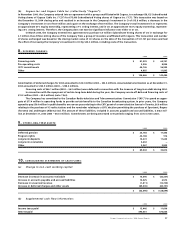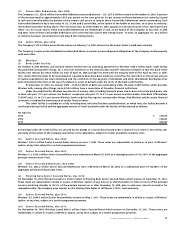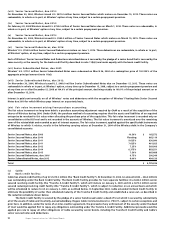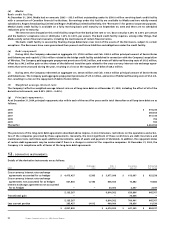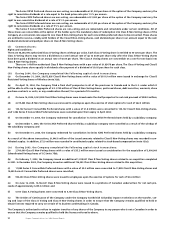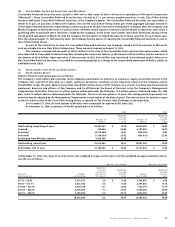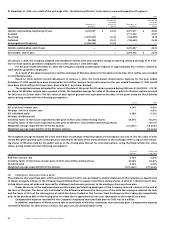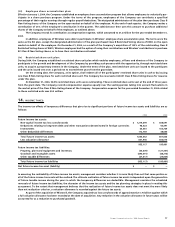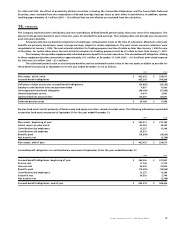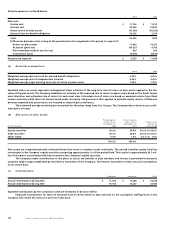Rogers 2004 Annual Report Download - page 92
Download and view the complete annual report
Please find page 92 of the 2004 Rogers annual report below. You can navigate through the pages in the report by either clicking on the pages listed below, or by using the keyword search tool below to find specific information within the annual report.
90 Rogers Communications Inc. 2004 Annual Report
(viii) Senior Secured Notes, due 2012:
On November 30, 2004, Wireless issued U.S. $470.0 million Senior Secured Notes which mature on December 15, 2012. These notes are
redeemable, in whole or in part, at Wireless’ option at any time, subject to a certain prepayment premium.
(ix) Senior Secured Notes, due 2014:
On February 20, 2004 Wireless issued U.S. $750.0 million of Senior Secured Notes due on March 1, 2014. These notes are redeemable, in
whole or in part, at Wireless’ option at any time, subject to a certain prepayment premium.
(x) Senior Secured Notes, due 2015:
On November 30, 2004, Wireless issued U.S. $550.0 million of Senior Secured Notes which mature on March 15, 2015. These notes are
redeemable, in whole or in part, at Wireless’ option at any time, subject to a certain prepayment premium.
(xi) Senior Secured Debentures, due 2016:
Wireless’ U.S. $154.9 million Senior Secured Debentures mature on June 1, 2016. These debentures are redeemable, in whole or in part,
at Wireless’ option, at any time, subject to a certain prepayment premium.
Each of Wireless’ Senior Secured Notes and Debentures described above is secured by the pledge of a senior bond that is secured by the
same security as the security for the bank credit facility described in note 11(b)(i) and ranks equally with the bank credit facility.
(xii) Senior Subordinated Notes, due 2007:
Wireless’ U.S. $179.1 million Senior Subordinated Notes were redeemed on March 26, 2004 at a redemption price of 102.933% of the
aggregate principal amount (note 11(e)).
(xiii) Senior Subordinated Notes, due 2012:
On November 30, 2004, Wireless issued U.S. $400.0 million Senior Subordinated Notes due on December 15, 2012. These notes are
redeemable in whole or in part, at Wireless’ option, at any time up to December 15, 2008, subject to a certain prepayment premium and
at any time on or after December 15, 2008 at 104.0% of the principal amount, declining ratably to 100.0% of the principal amount on or
after December 15, 2010.
Interest is paid semi-annually on all of Wireless’ notes and debentures with the exception of Wireless’ Floating Rate Senior Secured
Notes due 2010 for which Wireless pays interest on a quarterly basis.
(xiv) Fair value increment arising from purchase accounting:
The fair value increment on long-term debt is a purchase accounting adjustment required by GAAP as a result of the acquisition of the
shares of Wireless during 2004. Under GAAP, the purchase method of accounting requires that the assets and liabilities of an acquired
enterprise be revalued to fair value when allocating the purchase price of the acquisition. This fair value increment is recorded only on
consolidation at the RCI level and is not recorded in the accounts of Wireless. The fair value increment is amortized over the remaining
term of the related debt and recorded as part of interest expense. The fair value increment, applied against the specific debt instruments
of Wireless to which it relates, results in the following carrying values at December 31, 2004 of the Wireless debt in the Company’s
consolidated accounts:
Senior Secured Notes, due 2006 10.50% $ 165,572
Senior Secured Notes, due 2010 Floating 665,119
Senior Secured Notes, due 2011 9.625% 630,090
Senior Secured Notes, due 2011 7.625% 461,925
Senior Secured Notes, due 2012 7.25% 569,006
Senior Secured Notes, due 2014 6.375% 883,551
Senior Secured Notes, due 2015 7.50% 665,488
Senior Secured Debentures, due 2016 9.75% 200,349
Senior Subordinated Notes, due 2012 8.00% 484,126
Total $ 4,725,226
(c) Cable:
(i) Bank credit facility:
Cable has a bank credit facility of up to $1,075.0 million (the “Bank Credit Facility”). At December 31, 2004, no amount (2003 – $36.0 million)
was outstanding under the Bank Credit Facility. The Bank Credit Facility provides for two separate facilities: (i) a $600.0 million senior
secured revolving credit facility (the “Tranche A Credit Facility”), which will mature on January 2, 2009 and (ii) a $475.0 million senior
secured reducing/revolving credit facility (the “Tranche B Credit Facility”), which is subject to reduction on an annual basis and which
will be scheduled to reduce to nil on January 2, 2009, as outlined below. In September 2003, Cable amended its Bank Credit Facility to
eliminate the possibility of earlier than scheduled maturity of the Tranche B Credit Facility and established a carve-out, as described in
the reduction schedule shown below.
The Bank Credit Facility is secured by the pledge of a senior bond issued under a deed of trust which is secured by substantially
all of the assets of Cable and its wholly-owned subsidiary, Rogers Cable Communications Inc. (“RCCI”), subject to certain exceptions and
prior liens. In addition, under the terms of an inter-creditor agreement, the proceeds of any enforcement of the security under the deed
of trust would be applied first to repay any obligations outstanding under the Tranche A Credit Facility. Additional proceeds would be
applied pro rata to repay all other obligations of Cable secured by senior bonds, including the Tranche B Credit Facility and Cable’s
senior secured notes and debentures.


